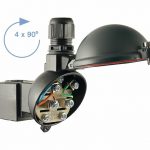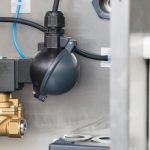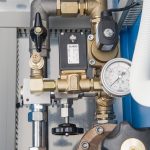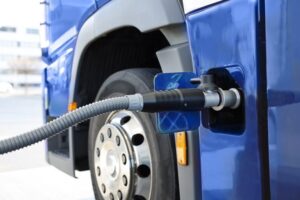Pressurised enclosure systems (Ex p) are a practical explosion protection method that is suitable for devices not approved for use in explosion-risk areas. Once installed inside a pressurised housing in accordance with IEC 60079-2, these devices can then be used directly in such areas. To prevent the ingress of a potentially explosive atmosphere into the housing, a protective gas like air or an inert gas is maintained at an overpressure inside the housing relative to the surrounding atmosphere.
Flexible ignition protection type
The German-based E.L.B Ex-Geräte Bachmann GmbH has long been regarded as a specialist for housings and control cabinets of this kind which comply with the Ex p ignition protection type. The control cabinets, which can be highly complex and are suitable for all explosion-risk areas in zones 1 and 2, are primarily used today in the chemical, petrochemical and pharmaceutical industries. “What users value above all is the flexibility offered by this type of protection. They can use standard components, which are also easier to replace when required; explosion protection only needs to be purchased once and the inventory of spare parts ties up less capital than, for example, intrinsically safe devices, which are substantially more expensive”, explains Managing Director Steffen Bachmann.
With the Ex p ignition protection type, overpressure regulation and monitoring in the control cabinet play a crucial role in explosion protection and, therefore, in the safety of the overall plant. The valves must likewise contribute to safety, given that they are responsible for supplying the protection gas and must perform two tasks simultaneously: rinsing the entire housing volume when the control cabinet doors are opened, e.g. for maintenance work, and maintaining the overpressure in the housing during operation in potentially explosive atmospheres. “What is required most of all are compact, reliable solutions that convince equally with excellent value for money”, Bachmann adds. “This is why we have worked closely with the fluidics specialists at Bürkert for more than a decade. As a result, the solenoid valves employed as rinsing valves have been continuously optimised and perfectly adapted for use in pressurised control cabinets.” The latest result of this collaboration is the 6281 solenoid valve, which immediately impresses with a whole range of practical features. Proven aspects of the design are retained, but the new solution is much more compact and the terminal box on the valve enables simpler and more flexible assembly.
Proven, economical and safe
Just like the predecessor 5281 model, the 6281 solenoid valves for use in pressurised control cabinets are equipped with Atex-certified type AC10 solenoid coils and have two adjustable throttles beneath the valve seat. This means that the valve closes as soon as the rinsing process has been successfully completed. However, adjustable throttles allow the valve block to be opened again to a defined position and set to the specific gas flow rate which is required to maintain the overpressure in the control cabinet, typically between 5 and 8 mbar. The pressure in the Ex p housing is continuously monitored. If it drops below a minimum level or exceeds the maximum, a warning appears. The leakage setting can then be changed accordingly. “Conversely, using proportional valves in the pressurised enclosure requires much more complicated regulation because the principles involved mean that the gas flow rate there is always dependent on ambient conditions; that in turn necessitates the use of a closed control circuit. Thanks to this purely mechanical solution, we can cut out this extra step”, says Bachmann enthusiastically. Since the control cabinets are used worldwide, the availability of suitably trained employees cannot always be guaranteed. Ultimately, the solenoid valves are approved for use in explosion-protected plants not only throughout Europe but also in Asia and Australia.
Yet another benefit of the tried and tested solenoid valves is that they work without power during normal operation of the plant. They only require electrical energy during the rinsing process, in other words, but not in order to maintain the overpressure. As a result, they don’t contribute to the accumulation of heat in the control cabinet. However, what is generally more important in practice is that the overpressure in the control cabinet is maintained in the event of a power failure because the mechanically set leakage value is still stored. The solenoid valves are therefore fail-safe. Even a defective valve will not trigger an interruption or a fault.
Terminal box for flexible assembly
The new solenoid valves have plenty more to offer than this. For instance, the terminal box for the Ex solenoid coils has been completely revised. It is not only more compact but can also be rotated through 90° using a special tool. Thanks to this flexibility, the number of variants is reduced, helping to streamline the order management and stock-keeping processes.
The terminal box has naturally retained tried and tested aspects of the design. As with the predecessor model, a type 1058 explosion-protected equipment fuse can also be installed. “This is much more practical than a fuse inside the device”, Bachmann reports. A further advantage is that opening and closing the terminal box only involves loosening one screw instead of the four screws previously required. “That saves an enormous amount of time and effort. After all, we install around 1000 of these valves each year,” he continues. “The terminal box is readily accessible, the lid easy to open and the workload lower.” What’s more, the solenoid valves with the Ex solenoid coils are optionally available as a variant for connection to cables. However, this solution is less flexible. “Cables in explosion-risk areas can be shortened but not easily lengthened. If the cable is too short, you need an additional on-site terminal box, which would significantly increase both the cost and the effort”, Bachmann points out. E.L.B. will therefore also give preference in future to solenoid valves equipped with a terminal box and an integrated fuse for its pressurised enclosure systems.
Online search: cpp0118bürkert
Hall 9, Booth G16











